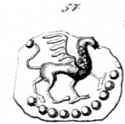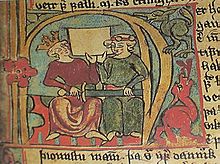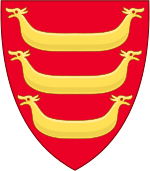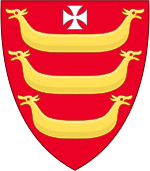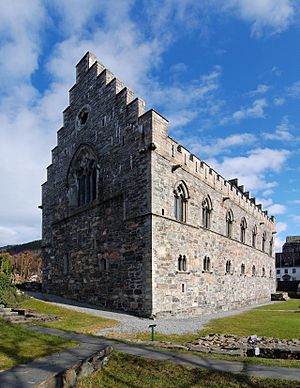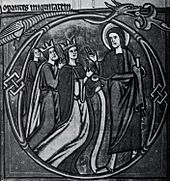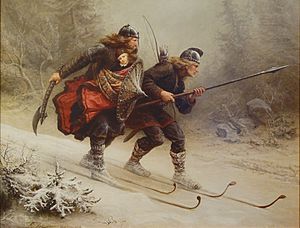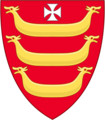Haakon IV facts for kids
Quick facts for kids Haakon IV |
|
|---|---|
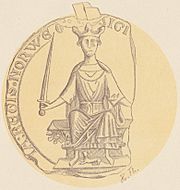
Haakon's seal, from a 1247/48 letter (with reverse). The seal itself was given to Haakon as a gift from Henry III of England in 1236.
|
|
| King of Norway | |
| Reign | June 1217 – 16 December 1263 |
| Coronation | 29 July 1247 (Bergen) |
| Predecessor | Inge II |
| Successor | Magnus VI |
| Junior kings |
|
| Born | c. March/April 1204 Folkenborg, Norway |
| Died | 16 December 1263 (aged 59) Kirkwall, Orkney, Norway |
| Burial |
|
| Spouse | |
| Issue among others... |
|
| House | Sverre |
| Father | Haakon III of Norway |
| Mother | Inga of Varteig |
| Religion | Roman Catholicism |
Haakon IV Haakonsson (born around March/April 1204 – died 16 December 1263) was the King of Norway for 46 years, from 1217 to 1263. He is sometimes called Haakon the Old to tell him apart from his son, Haakon the Young. His long reign was a very important time for Norway.
Haakon was born during a difficult period of civil war in Norway. But he managed to bring these conflicts to an end. At the start of his rule, when he was still young, Earl Skule Bårdsson helped him govern. Haakon was part of the birkebeiner group. He defeated the last rival king, Sigurd Ribbung, in 1227. The civil war finally ended in 1240 when Skule Bårdsson, who had tried to become king himself, was killed. After this, Haakon made his own son a junior king to rule alongside him.
Under King Haakon's leadership, medieval Norway became very powerful and prosperous. This time is often called Norway's "golden age." Haakon was respected by leaders across Europe. He even had good relationships with both the Pope and the Holy Roman Emperor, even though they were often fighting each other. He was offered important roles, like becoming Holy Roman Emperor or leading a French crusader fleet.
Haakon also brought more European culture to Norway. He had many European stories translated into Old Norse. He also built impressive stone buildings in the European style. He was very active in foreign policy, expanding Norway's influence. By the end of his reign, he added Iceland and Greenland to his kingdom. This made Norway the largest it had ever been. He died in Orkney after a military campaign against Scotland.
Contents
- Learning About King Haakon IV
- Haakon's Early Life and Challenges
- Becoming King: The Succession Struggle
- Gaining Papal Recognition
- Cultural Growth and New Laws
- Norway's Role in Europe
- The Scottish Expedition and Haakon's Death
- Haakon's Family and Marriage
- Haakon in Popular Culture
- Images for kids
- See also
Learning About King Haakon IV
The main source of information about King Haakon is the Saga of Haakon Haakonsson. A saga is a type of long story or history written in medieval times. This saga was written right after Haakon's death by an Icelandic writer named Sturla Þórðarson. Haakon's son, Magnus, asked Sturla to write it.
The saga is considered very detailed and reliable. It used official records and stories from people who knew Haakon well. However, it was written to support Haakon's family and his right to be king.
Haakon's Early Life and Challenges
Haakon was born in Folkenborg in the summer of 1204. His mother was Inga of Varteig. Many believed his father was King Haakon Sverresson. He was the leader of the birkebeiner group, who were fighting the bagler in a civil war. King Haakon Sverresson died before his son Haakon was born.
Haakon was born in an area controlled by the bagler. This put him and his mother in danger. In the winter of 1205/06, some birkebeiner warriors bravely fled with the baby. They carried him over a snowy mountain to reach King Inge Bårdson in Nidaros (now Trondheim). This dramatic journey is celebrated today by a popular skiing event called Birkebeinerrennet.
Haakon was described as smart and witty, but small for his age. When he was only three, the bagler captured him. But he refused to call the bagler king his lord. At eight, he learned that an agreement about the throne excluded him. He cleverly said the agreement was not valid because his lawyer was not there. He then said his lawyers were "God and Saint Olaf."
Haakon was the first Norwegian king to get a formal education at a school. He started school in Bergen at age seven. He continued his studies in Trondheim later. This education was important because the government was starting to use more written documents.
Becoming King: The Succession Struggle
After King Inge died in 1217, there was a big argument about who should be the next king. Haakon had the support of most of the birkebeiners. Other candidates included Inge's half-brother, Earl Skule Bårdsson. Skule was supported by the Archbishop.
In June 1217, Haakon was declared king at a meeting in Trøndelag. Later that year, he was also recognized as king in Bergen and other parts of Norway. Skule's supporters tried to question Haakon's royal birth. But they eventually stopped openly fighting his claim. To avoid another civil war, Skule agreed to be Haakon's helper (regent) while Haakon was still a minor.
To prove Haakon's royal birth, his mother Inga had to go through a special test called a trial by ordeal in 1218. The trial's result confirmed his parentage. This strengthened Haakon's right to be king and improved his relationship with the church.
Skule and Haakon started to govern separately. Skule mainly ruled Eastern Norway. In 1223, a large meeting was held in Bergen with important leaders. They finally decided that Haakon was the rightful King of Norway.
The last bagler king died in 1217. Skule helped bring peace between the birkebeiner and bagler groups. But some unhappy bagler found a new leader, Sigurd Ribbung, and started another uprising in 1219. This revolt mostly happened in Eastern Norway. In 1223, Skule managed to make the Ribbungar surrender.
However, Ribbung escaped in 1224. Haakon had to fight him alone. Skule did not help much. Haakon led a strong army and defeated Ribbung. He even led an army into Sweden in 1225 to punish people who supported Ribbung. Ribbung died in 1226, and the revolt finally ended in 1227. This made Haakon the undisputed king.
To try and make peace between Haakon and Skule, Haakon's advisors suggested he marry Skule's daughter, Margaret Skulesdatter. Haakon agreed, and they married in 1225. But their relationship still got worse in the 1230s.
In 1237, Skule was given the title of duke. This was the first time someone in Norway had this title. But instead of ruling a region, he got income from different parts of Norway. This was Haakon's way of trying to limit Skule's power. In 1239, the conflict turned into open war when Skule declared himself king. Haakon's forces were stronger. The rebellion ended when Skule was killed in 1240. This event is seen as the final end of Norway's civil war era.
Gaining Papal Recognition
Even though Haakon was the undisputed ruler after 1240, the Pope had not officially approved him as king. This was because Haakon was born outside of marriage. Haakon really wanted to be fully recognized as a European king. He declared his legitimate son, Haakon the Young, as his successor. This was important for the church's rules about who could inherit the throne.
Haakon also promised to go on a crusade to strengthen his ties with the Pope. In 1241, he changed this to a vow to fight pagan people in the north. He allowed a group of people called Karelians, who were forced west by the Mongols, to stay in Norway and become Christians. This pleased the Pope.
Later, in 1248, the King of France asked Haakon to join a crusade. He wanted Haakon to command the fleet. But Haakon said no. Finally, in 1246, Pope Innocent IV officially recognized Haakon as king. A special church leader, Cardinal William of Sabina, came to Bergen and crowned Haakon in 1247.
Cultural Growth and New Laws
After becoming the undisputed king in 1240, Haakon focused on showing the power of the kingship. He was influenced by the growing contact with European culture. He started building many grand royal buildings. His most famous one is a European-style stone palace in Bergen.
Haakon also used a large fleet of impressive royal ships when meeting other Scandinavian rulers. He sent letters and gifts to other European leaders. He even sent falcons to the sultan of Tunis.
The royal court in Bergen also started bringing in and translating European literature. This was the first time such literature became widely available in Norway. Popular stories included tales about Charlemagne and King Arthur. The first work translated into Old Norse was the romantic story Tristan and Iseult in 1226. This started a new type of Norse literature called chivalric sagas.
Haakon also had the religious text Visio Tnugdali translated. This was called Duggals leiðsla in Old Norse. This literature was also popular with women. Haakon's wife and daughter owned beautifully illustrated prayer books.
Haakon also started important legal reforms. His "New Law," written around 1260, was a big step for public justice. It moved away from old Norwegian customs of feuds and revenge. The influence of these reforms can also be seen in Haakon's King's Mirror. This was an educational text written for his son Magnus.
Norway's Role in Europe
Haakon had difficult relationships with Sweden and Denmark early in his reign. But he managed to maintain friendships with both the Pope and the Holy Roman Emperor, even though they were enemies. Other European rulers wanted to be friends with Haakon because of his powerful navy. Some even suggested the Pope wanted Haakon to become Holy Roman Emperor.
Haakon was very active in foreign policy. In the northeast, he improved relations with Novgorod. This likely strengthened Norway's control over Troms and Finnmark. An embassy from Novgorod once asked for Haakon's daughter Christina's hand in marriage. But Haakon refused because of the Mongol threat.
Norway relied on grain from Lübeck in the Baltic Sea. In 1250, Haakon made a peace and trade agreement with Lübeck. This opened the city of Bergen to the Hanseatic League. Haakon also tried to expand his kingdom south into the Danish province of Halland. He even invaded Halland in 1256. But he had to give up his claims in 1257 after a peace agreement with Denmark.
Haakon also sought an alliance with Alfonso X of Castile in Spain. He sent his daughter Christina to Castile to marry one of Alfonso's brothers. However, Christina died childless four years later. This ended the short alliance.
The Scottish Expedition and Haakon's Death
Haakon worked hard to strengthen Norway's ties with countries in the west. He had a strong friendship and trade relationship with the English king, Henry III of England. Haakon wanted to protect Norway's control over islands like the Hebrides, Man, Shetland, Orkney, and the Faroe Islands.
In 1261, the Norse community in Greenland agreed to be ruled by the Norwegian king. In 1262, Haakon achieved a major goal by adding Iceland to his kingdom. He used the internal conflicts on the island to his advantage. By the end of Haakon's reign, the Norwegian kingdom was at its largest ever.
However, Scotland wanted to control the Hebrides. The Scottish king, Alexander II, tried to buy the islands from Norway. Haakon firmly refused. After Alexander II died, his son Alexander III continued to claim the islands. He even attacked the Hebrides in 1261.
In 1263, the dispute with Scotland led Haakon to launch a large expedition. He sailed with a huge fleet of at least 120 ships. The fleet left Bergen in July and reached Shetland and Orkney in August. Scottish nobles had raided the Hebrides, and Alexander III planned to conquer them.
Negotiations with Alexander were purposely delayed by the Scots. In September/October, a small battle happened at Battle of Largs. Haakon then withdrew to Orkney for the winter. A group of Irish kings invited Haakon to become the High King of Ireland. They wanted him to help expel the Anglo-Norman settlers. But this offer was refused.
Haakon spent the winter at the Bishop's Palace in Kirkwall, Orkney. He planned to continue his campaign the next year. But he became ill and died on 16 December 1263. Haakon was buried in St Magnus Cathedral in Kirkwall for the winter. In the spring, his body was taken back to Norway. He was buried in the Old Cathedral in his capital, Bergen. This cathedral was later destroyed in 1531.
Haakon's Family and Marriage
Before his marriage, Haakon had three children with his mistress, Kanga the Younger.
- Sigurd (died 1252).
- Cecilia (died 1248). She married Gregorius Andresson in 1241. Later, she married Harald Olafsson, King of Mann and the Isles, in 1248. They both drowned that same year.
- Kone (born around 1225). She married Toralde Gunnarsson Hvite.
Haakon married Margrete Skulesdatter on 25 May 1225. She was the daughter of his rival, Earl Skule Bårdsson. Their children were:
- Olav (born 1226). He died as a baby.
- Haakon the Young (1232–1257). He married Rikissa Birgersdotter in 1251. His father made him a junior king in 1240. But he died before his father.
- Christina (1234–1262). She married Infante Philip of Castile in 1258. She died without children.
- Magnus VI of Norway (1238–1280). He married Ingeborg in 1261. He became junior king after Haakon the Young died. He became King of Norway after his father's death.
Haakon in Popular Culture
The mascots for the 1994 Winter Olympics were named Håkon and Kristin. Håkon was named after Haakon IV of Norway. Kristin was named after his daughter, Christina of Norway.
In the 2016 film The Last King, the baby Haakon IV is played by Jonathan Oskar Dahlgren.
Images for kids
-
Coats of arms accorded to Haakon by Matthew Paris.
See also
 In Spanish: Haakon IV de Noruega para niños
In Spanish: Haakon IV de Noruega para niños


